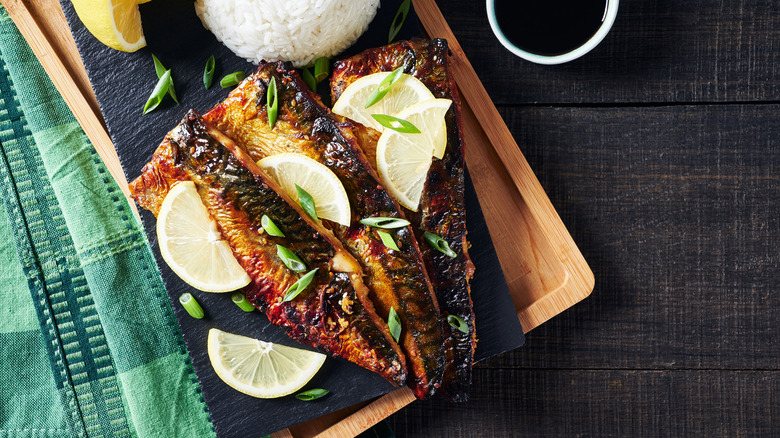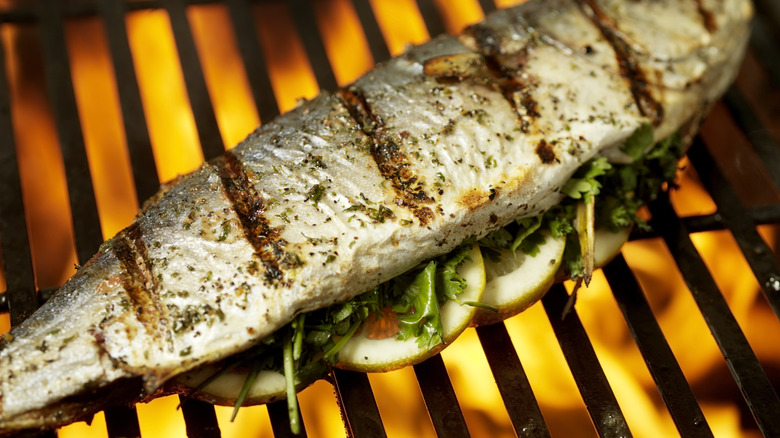José Andrés Thinks You're Missing The Best Part Of Grilled Fish
Warm, buttery, and delicious, a humble plate of grilled fish is a wonderful, wholesome indulgence, but it comes with a few drawbacks too. The flesh of a fish can be fragile and flaky, so it's not always the easiest to cook. There are plenty of mistakes to avoid when cooking fish to prevent a lackluster final product, but in an interview with Food & Wine, chef José Andrés shared one in particular he believes is one of the biggest. According to Andrés, plenty of chefs are missing out on an integral part of grilled fish. The chef shared in the interview, "A lot of people don't use the skin. They're probably missing the best part."
Just like the skin of a chicken helps to hold in moisture and fat and, in turn, flavor, the skin of a fish offers those same exact benefits. Fish skin helps fish retain its natural oils while it's grilling. Plus, when properly seared, fish skin can also provide a nice crispy contrast to the soft, buttery flesh of the rest of the protein. This is especially true of species like flounder, sea bass, or salmon, to name just a few.
More enticing benefits of fish skin
Fish skin is one of the healthiest parts of the fish, and is packed with plenty of fatty omega-3 acids and proteins to help the heart and brain function, as well as to aid in muscle growth. Additionally, the skin comes packed with additional gelatin too, which, much like collagen, can help improve skin health.
Flavor and safety aside, fish skin also makes for a simpler cooking process. While one of the caveats of grilling fish is how easily it can stick and crumble under the heat of the grill, if you leave the skin on, then you don't have to worry so much. Fish skin provides a convenient safety layer between the soft, delicate flesh of the fish and the grill, so it can help widen any margin of error, preventing any flesh from sticking and melting onto your grill grates. Grill your fish skin-side down to prevent the flesh from drying or charring, leaving you with a beautifully warmed, caramelized flesh instead.
In addition to leaving the skin on, José Andrés told Food & Wine that choosing the right heat setting on your grill helps too. "Like always, the key to metal and protein and gelatin and skin is that you need to make sure that the grill is really hot," he shared. "When things are hot, nothing ever sticks." (And when in doubt, you could even try this cheap fix that makes grilled fish taste luxurious.)
Why some might be averse to this essential savory layer
If fish skin offers all these bonuses, then why is it that so many chefs have taken to peeling it off and scraping it? Sometimes the answer is as simple and human as people are scared of how it looks. Tough and scaly when raw, a fish's skin is not the most appetizing thing to look at. Additionally, not all fish skin is equal. While the skin of salmon, mackerel, or sea bass is fit for grilling, others like tuna will be too tough and won't lend a good end result. Improperly preparing fish skin can also lead to unsavory plates. For example, fish skin should always be dry before grilling, not wet, to avoid uneven cooking. Similarly, if you're not grilling or searing your fish, keeping the skin on might not be the best option anyway. Fish that's being steamed or pouched will end up with limp, gummy, and lifeless skin instead of crunchy and crisp, which doesn't do much in the flavor or texture departments.
As long as you know when and how to keep the skin on, you should be good to go. So, when it's time to grill up some salmon, don't repeat the same mistake everyone makes with fish skin. Listen to José Andrés' advice instead, and prepare to dive into a truly delicious, fishy plate.


